The Basse-Terre Island of Guadeloupe (Eastern Caribbean, France) and Its Volcanic-Hydrothermal Geodiversity: A Case Study of Challenges, Perspectives, and New Paradigms for Resilience and Sustainability on Volcanic Islands
Abstract
:1. Introduction
2. Context and Geo-Volcanological Background
2.1. Geographical and Geological Setting of the Guadeloupe Island and Archipelago
2.2. The Basse-Terre Eruptive Centres
2.3. La Soufrière Volcano and the Ongoing Unrest
3. An Overview of the Water Resource in the Volcanic Context of the Basse-Terre Island
3.1. Climate-Related Drivers
3.2. Groundwaters and Geothermal Systems
3.2.1. The Bouillante Geothermal Field
- (a)
- Anse Thomas, where it is possible to bathe in a small basin on the coastline, in which thermal water ~70 °C at and sea water mix resulting in a ~10 m2 pool by the sea at ~50 °C (Figure 8);
- (b)
- Monchy, on the beach of Petite Anse, where hot water emerges from directly under the sand at the edge of the cliff. The spring can no more be sampled after the 1995 hurricane, but its temperature was between 40 °C and 50 °C;
- (c)
- Anse à la Barque, which is here included in the Bouillante sector (see also Brombach et al. 2000 [46]) but that some ascribe to the Sans Toucher/Vieux Habitants hydrothemal system via an E–W fault (Bourdon et al. 2008 [68]). Thermal waters are located below the lava flows surrounding the bay and diffuse in the sand by the sea at an average temperatures of 40 °C (Bourdon et al. 2008 [68]). Other water resurgences are located in the nearby mangroves. Water composition result from mixing low-mineral and sea water at variable proportions;
- (d)
- Bain du Curé (close to the Anse à sable beach), partially equipped since the 1950s with a ~2 m2 concrete pool and having a temperature around 40 °C. Hot water comes directly into the rock of the coastal cliff. In order to increase the spring flow-rate, the rock was dynamited causing the opposite effect, the reduction in flow-rate. In the area other sources are at sea around the Pigeon Island; and
- (e)
- La Lise, in the Bois-Malher valley, which is a completely abandoned site, in which the hot (>40 °C) water comes out on the ground over the entire area and is collected in three basins about 1 m deep and 4 m2 wide each. The waters are naturally filtered from the ground with sand at the bottom of the pools.
3.2.2. The Very Active Volcanic-Hydrothermal System of La Soufrière
La Soufrière Fumarolic Field
Hot Springs and Thermal Waters around La Soufrière
- (a)
- Bains Jaunes (BJ), Carbet Echelle (CE), Galion (Ga), Tarade (Ta), Ravine Marchand (RM), Pas du Roy (PR), and Bains Chauds-Matouba-Eaux Vives (BCM-EV) are Ca-SO4 waters, also transitioning to ASC waters such as in the case of Galion and Tarade because of dissolution of SO2 and HCl of deep volcanic origin (Figure 7; Villemant et al. 2014 [45]);
- (b)
- Habitation Revel (HR) is Ca-Na–HCO3- water (HR), likely representing a shallow water conductively heated; and
- (c)
- Chute du Carbet (CC) and Grosse Corde (GC) are Ca-Na-Cl- waters.
3.2.3. Other Thermal Springs: Dolé Area, Ravine Chaude, and Sofaia
4. Discussion on Perspectives and Challenges for Resilience and Sustainability
4.1. A Unique Natural Laboratory for Climate-Volcanic Activity Interaction on Geodiversity, Biodiversity, and Ecosystem Response
4.2. Energy, Particularly Geothermal
4.3. From Volcanic-Hydrothermal Geodiversity to a Responsive and Resilience-Driven Plan of Sustainable Development
4.3.1. The Challenge of Hydrothermal and Volcanic Hazards
4.3.2. The Challenge of the Volcanic Shock Consequences
- (a)
- The total natural risk observatory with its continuous and participative monitoring of geodiversity and biodiversity and evolution related to short-term and long-term natural hazards;
- (b)
- The rapid restoration of the energy supply, based on stock but also on the utilization of diffuse power sources related to geothermal energy and water; and
- (c)
- Quick deployment, supplying and provisioning of needed livelihood and stocks, particularly water owing to the use of well-characterized strategic deep groundwater resources.
5. Conclusions
Author Contributions
Funding
Acknowledgments
Conflicts of Interest
References
- De Wever, P.; Alterio, I.; Egoroff, G.; Cornée, A.; Bobrowsky, P.; Collin, G.; Duranthon, F.; Hill, W.; Lalanne, A.; Page, K.N. Geoheritage, a National Inventory in France. Geoheritage 2015, 7, 205–247. [Google Scholar] [CrossRef] [Green Version]
- Chauvet, M.; Bourdon, E.; Bès de Berc, S.; Legendre, L.; Mompelat, J.-L. Un inventaire pilote des sites géologiques remarquables de Guadeloupe. In Découvrir le Patrimoine Géologique de la France; Géosciences: Ardeche, France, 2008; pp. 176–181. [Google Scholar]
- Brocx, M.; Semeniuk, V. Geoheritage and geoconservation-history, definition, scope and scale. J. R. Soc. West. Aust. 2007, 90, 53–87. [Google Scholar]
- Bès de Berc, S.; Chauvet Lebrun, J.F.; Léticée, J.L.; Randrianasolo, A.; Traineau, H. Inventaire des Sites Géologiques Remarquables de la Guadeloupe (Phase 2)—Rapport Final. BRGM Report BRGM/RP-55737-FR. 2007, p. 75. Available online: https://dokumen.tips/documents/inventaire-des-sites-geologiques-remarquables-de-la-guadeloupe-.html (accessed on 25 August 2021).
- Bézèlgues-Courtade, S.; Bes-De-Berc, S. Inventaire et Caractérisation des Sources Thermales de Guadeloupe, Rapport Final; Report BRGM/RP-55060-FR; BRGM: Orléans, France, 2007; p. 116. [Google Scholar]
- Conseil Régional de Guadeloupe. Atlas des Paysages de L’archipel Guadeloupe; Deal de Guadeloupe: Guadeloupe, France, 2013. [Google Scholar]
- De Wever, P.; Egoroff, G.; Cornée, A.; Lalanne, A. Géopatrimoine en France. Mém. H.S. Soc. Géol. Fr. 2014, 14, 180. [Google Scholar]
- Mazabraud, Y. Historical and Contemporary Use of Natural Stones in the French West Indies. Conservation Aspects and Practices. Sustainability 2019, 11, 4566. [Google Scholar] [CrossRef] [Green Version]
- Feuillet, N.; Manighetti, I.; Tapponnier, P. Arc parallel extension and localization of volcanic complexes in Guadeloupe, Lesser Antilles. J. Geophys. Res. 2002, 107, 2331. [Google Scholar] [CrossRef]
- Rosas-Carbajal, M.; Komorowski, J.-C.; Nicollin, F.; Gibert, D. Volcano electrical tomography unveils edifice collapse hazard linked to hydrothermal system structure and dynamics. Sci. Rep. 2016, 6, 29899. [Google Scholar] [CrossRef] [Green Version]
- Brothelande, E.; Finizola, A.; Peltier, A.; Delchera, E.; Komorowski, J.-C.; Di Gangi, F.; Borgogno, G.; Passarella, M.; Trovato, C.; Legendre, Y. Fluid circulation pattern inside La Soufrière volcano (Guadeloupe) inferred from combined electrical resistivity tomography, self-potential, soil temperature and diffuse degassing measurements. J. Volcnol. Geotherm. Res. 2014, 288, 105–122. [Google Scholar] [CrossRef] [Green Version]
- Turner, S. Promoting UNESCO Global Geoparks for sustainable development in the Australian-Pacific region. Alcheringa Australas. J. Palaeontol. 2006, 31, 351–365. [Google Scholar] [CrossRef]
- Lew, A. Geotourism and what geographers do. Tour. Geogr. 2002, 4, 347–348. [Google Scholar] [CrossRef]
- Buckley, R. Environmental Inputs and Outputs in Ecotourism: Geotourism with a Positive Triple Bottom Line? J. Ecotour. 2003, 2, 76–82. [Google Scholar] [CrossRef] [Green Version]
- Kim, S.; Kim, M.; Park, J.; Guo, Y. Cave tourism: Tourists’ characteristics, motivations to visit, and the segmentation of their behavior. Asia Pac. J. Tour. Res. 2008, 13, 299–318. [Google Scholar] [CrossRef]
- Dowling, R.; Newsome, D. Geotourism: Definition, characteristics and international perspectives. In Handbook of Geotourism; The Geologists’ Association: London, UK, 2018; pp. 1–22. [Google Scholar] [CrossRef] [Green Version]
- Oikawa, T.; Yoshimoto, M.; Nakada, S.; Maeno, F.; Komori, J.; Shimano, T.; Takeshita, Y.; Ishizuka, Y.; Ishimine, Y. Reconstruction of the 2014 eruption sequence of Ontake Volcano from recorded images and interviews. Earth Planets Space 2016, 68, 79. [Google Scholar] [CrossRef] [Green Version]
- Lim, Z.Y.; Flaherty, G. Fiery eruptions: Travel health risks of volcano tourism. J. Travel Med. 2020, 27. [Google Scholar] [CrossRef]
- Moretti, R.; Komorowski, J.-C.; Ucciani, G.; Moune, S.; Jessop, D.; de Chabalier, J.-B.; Beauducel, F.; Bonifacie, M.; Burtin, A.; Vallée, M.; et al. The 2018 unrest phase at La Soufrière of Guadeloupe (French West Indies) andesitic volcano: Scrutiny of a failed but prodromal phreatic eruption. J. Volcanol. Geotherm. Res. 2020, 393, 106769. [Google Scholar] [CrossRef]
- Préfet de la Région Guadeloupe. 2021. Available online: http://www.guadeloupe.developpement-durable.gouv.fr/IMG/pdf/dp_journees_japonaises_21062021.pdf (accessed on 30 September 2021).
- Andrews, G.R. Why the Volcano Erupting in the Caribbean has such a Deadly Reputation. National Geographic. 2021. Available online: www.nationalgeographic.com/science/article/why-st-vincent-volcano-erupting-in-caribbean-has-such-a-deadly-reputation (accessed on 30 September 2021).
- Chanteur, B.; Reif, X. Recensement de la population en Guadeloupe; Insee Flash, 142; Insee: Paris, France, 2020; pp. 2416–8211. [Google Scholar]
- Boudon, G.; Komorowski, J.-C.; Villemant, B.; Semet, M.P. A new scenario for the last magmatic eruption of La Soufrière of Guadeloupe (Lesser Antilles) in 1530 A.D. Evidence from stratigraphy radiocarbon dating and magmatic evolution of erupted products. J. Volcanol. Geotherm. Res. 2008, 178, 474–490. [Google Scholar] [CrossRef]
- Samper, A.; Quidelleur, X.; Komorowski, J.C.; Lahitte, P.; Boudon, G. Effusive history of the grande decouverte volcanic complex, southern basse-terre (guadeloupe, french west indies) from new k–ar cassignol–gillot ages. J. Volcanol. Geotherm. Res. 2009, 187, 117–130. [Google Scholar] [CrossRef]
- Blanc, F. Corrélations chronologiques et géochimiques des formations volcaniques du sud de la Basse-Terre de Guadeloupe (Petites Antillesl), Début du cycle récent. Ph.D. Thesis, Université Scientifique et Médicale de Grenoble, Grenoble, France, 1983; p. 17. [Google Scholar]
- Carlut, J.; Quidelleur, X.; Courtillot, V.; Boudon, G. Paleomagnetic directions and K/Ar dating of 0 to 1 Ma old lava flows from La Guadeloupe Island (French West Indies): Implications for time averaged field models. J. Geophys. Res. 2000, 105, 835–849. [Google Scholar] [CrossRef] [Green Version]
- Carlut, J.; Quidelleur, X. Absolute paleointensities recorded during the Brunhes chron at La Guadeloupe island. Phys. Earth Planet. Inter. 2000, 120, 255–269. [Google Scholar] [CrossRef]
- Samper, A.; Quidelleur, X.; Lahitte, P.; Mollex, D. Timing of effusive volcanism and collapse events within an oceanic arc island: Basse-Terre, Guadeloupe archipelago (Lesser Antilles). Earth Planet Sci. Lett. 2007, 258, 175–191. [Google Scholar] [CrossRef]
- Legendre, Y. Reconstruction Fine de L’histoire Eruptive Et Scenarii Eruptifs à la Soufrière de Guadeloupe: Vers un Modèle Intégré de Fonctionnement du Volcan. Ph.D. Thesis, Université de Paris, Paris, France, 2012. [Google Scholar]
- Komorowski, J.-C.; Boudon, G.; Semet, M.; Beauducel, F.; Anténor-Habazac, C.; Bazin, S.; Hammouya, G. Guadeloupe. In Volcanic Atlas of the Lesser Antilles, Seismic Research Unit; The University of the West Indies: St. Augustine, Trinidad and Tobago, 2005; pp. 65–102. [Google Scholar]
- Peruzzetto, M.; Komorowski, J.-C.; Le Friant, A.; Rosas-Carbajal, M.; Mangeney, A.; Legendre, Y. Modeling of partial dome collapse of La Soufrière of Guadeloupe volcano: Implications for hazard assessment and monitoring. Sci. Rep. 2019, 9, 13105. [Google Scholar] [CrossRef] [PubMed]
- Dorel, J.; Feuillard, M. Note sur la crise sismo-volcanique à la Soufriére de la Guadeloupe 1975–1977. Bull. Volcanol. 1980, 43, 419–430. [Google Scholar] [CrossRef]
- Feuillard, M.; Allégre, C.J.; Brandéis, G.; Gaulon, R.; Le Mouël, J.L.; Mercier, J.C.; Pozzi, J.P.; Semet, M.P. The 1975–1977 crisis of La Soufriére de Guadeloupe (F.W.I): A still-born magmatic eruption. J. Volcanol. Geotherm. Res. 1983, 16, 317–334. [Google Scholar] [CrossRef]
- Labat, J.-B. Voyage aux Iles, Chroniques Aventureuse des Caraïbes 1693–1705; Phebus Libretto: Paris, France, 1993; pp. 56–71. [Google Scholar]
- Biot Mercier, D. La Guadeloupe—Explication de la Figure, Eruption d’eau. C. R. Acad. Sci. Paris 1837, IV, 651–654. [Google Scholar]
- Barabé, L.; Jolivet, J. Les récentes manifestations d’activité de la Guadeloupe (Petites Antilles). Bull. Volcanol. 1958, 19, 143–158. [Google Scholar] [CrossRef]
- Hincks, T.K.; Komorowski, J.C.; Sparks, S.R.; Aspinall, W.P. Retrospective analysis of uncertain eruption precursors at La Soufrière volcano, Guadeloupe, 1975–1977: Volcanic hazard assessment using a Bayesian Belief Network approach. J. Appl. Volcanol. 2014, 3, 3. [Google Scholar] [CrossRef] [Green Version]
- Komorowski, J.-C.; Hincks, T.; Sparks, R.; Aspinall, W. Improving crisis decision-making at times of uncertain volcanic unrest (Guadeloupe, 1976). Glob. Volcan. Hazards Risk 2015, 255–262. [Google Scholar] [CrossRef]
- Le Friant, A.; Boudon, G.; Komorowski, J.-C.; Heinrich, P.; Semet, M.P. Potential Flank-Collapse of Soufrière Volcano, Guadeloupe, Lesser Antilles? Numerical Simulation and Hazards. Nat. Hazards 2006, 39, 381–393. [Google Scholar] [CrossRef]
- Salaün, A.; Villemant, B.; Gérard, M.; Komorowski, J.-C.; Michel, A. Hydrothermal alteration in andesitic volcanoes: Trace element redistribution in active and ancient hydrothermal systems of Guadeloupe (Lesser Antilles). J. Geochem. Explor. 2011, 111, 59–83. [Google Scholar] [CrossRef]
- Heap, M.J.; Baumann, T.S.; Rosas-Carbajal, M.; Komorowski, J.; Gilg, H.A.; Villeneuve, M.; Moretti, R.; Baud, P.; Carbillet, L.; Harnett, C.; et al. Alteration-Induced Volcano Instability at La Soufrière de Guadeloupe (Eastern Caribbean). J. Geophys. Res. Solid Earth 2021, 126. [Google Scholar] [CrossRef]
- Zlotnicki, J.; Boudon, G.; Le Mouël, J.L. The volcanic activity of La Soufriére of Guadeloupe (Lesser Antilles): Structural and tectonic implications. J. Volcanol. Geotherm. Res. 1992, 49, 91–104. [Google Scholar] [CrossRef]
- Allard, P.; Hammouya, G.; Parello, F. Dégazage magmatique diffus à la Soufrière de Guadeloupe, Antilles. C. R. Acad. Sci. Ser. IIA Earth Planet. Sci. 1998, 327, 315–318. [Google Scholar] [CrossRef]
- Villemant, B.; Hammouya, G.; Michel, A.; Semet, M.P.; Komorowski, J.-C.; Boudon, G.; Cheminée, J.-L. The memory of volcanic waters: Shallow magma degassing revealed by halogen monitoring in thermal springs of La Soufrière volcano (Guadeloupe, Lesser Antilles). Earth Planet. Sci. Lett. 2005, 237, 710–728. [Google Scholar] [CrossRef]
- Villemant, B.; Komorowski, J.C.; Dessert, C.; Michel, A.; Crispi, O.; Hammouya, G.; De Chabalier, J.B. Evidence for a new shallow magma intrusion at La Soufrière of Guadeloupe (Lesser Antilles): Insights from long-term geochemical monitoring of halogen-rich hydrothermal fluids. J. Volcanol. Geotherm. Res. 2014, 285, 247–277. [Google Scholar] [CrossRef] [Green Version]
- Villemant, T.; Marini, L.; Hunziker, J.C. Geochemistry of the thermal springs and fumaroles of Basse-Terre Island, Guadeloupe, Lesser Antilles. Bull. Volcanol. 2000, 61, 477–490. [Google Scholar] [CrossRef]
- Allard, P.; Aiuppa, A.; Beauducel, F.; Gaudin, D.; Di Napoli, R.; Calabrese, S.; Parello, F.; Crispi, O.; Hammouya, G.; Tamburello, G. Steam and gas emission rate from La Soufriere volcano, Guadeloupe (Lesser Antilles): Implications for the magmatic supply during degassing unrest. Chem. Geol. 2014, 384, 76–93. [Google Scholar] [CrossRef]
- OVSG-IPGP (1999-2021) Bilan Mensuel de L’activité Volcanique de la Soufrière et et de la Sismicité Régionale. Available online: http://www.ipgp.fr/fr/ovsg/bulletins-mensuels-de-lovsg (accessed on 30 September 2021).
- Mastin, L.G. Thermodynamics of gas and steam-blast eruptions. Bull. Volcanol. 1995, 57, 85–98. [Google Scholar] [CrossRef]
- Jessop, D.E.; Moune, S.; Moretti, R.; Gibert, D.; Komorowski, J.-C.; Robert, V.; Heap, M.J.; Bosson, A.; Bonifacie, M.; Deroussi, S.; et al. A multi-decadal view of the heat and mass budget of a volcano in unrest: La Soufrière de Guadeloupe (French West Indies). Bull. Volcanol. 2021, 83, 1–19. [Google Scholar] [CrossRef]
- Sanjuan, B.; Bouchot, V.; Gadalia, A.; Traineau, H. Géothermie haute température: Le dé énergétique. Géosciences 2011, 2011, 32–41. [Google Scholar]
- Office de l’Eau 971. Eau et Assainissement: Les Chiffres Clés; Office de l’ Eau Guadeloupe: Gourbeyre, France, 2020; 60p.
- Raguenel, M.; Driesner, T.; Bonneau, F. Numerical modeling of the geothermal hydrology of the Volcanic Island of Basse-Terre, Guadeloupe. Geotherm. Energy 2019, 7, 28. [Google Scholar] [CrossRef] [Green Version]
- Chaperon, P.; L’Hote, Y.; Vuillaume, G. Les ressources en eau de surface de la Guadeloupe. Cahier ORSTQM Ser. Hydrologie 1983, XX, 149–178. [Google Scholar]
- Dessert, C.; Lajeunesse, E.; Lloret, E.; Clergue, C.; Crispi, O.; Gorge, C.; Quidelleur, X. Controls on chemical weathering on a mountainous volcanic tropical island: Guadeloupe (French West Indies). Geochim. Cosmochim. Acta 2015, 171, 216–237. [Google Scholar] [CrossRef]
- Allemand, P.; Delacourt, C.; Lajeunesse, E.; Devauchelle, O.; Beauducel, F. Erosive effects of the storm Helena (1963) on Basse Terre Island (Guadeloupe-Lesser Antilles Arc). Geomorphology 2014, 206, 79–86. [Google Scholar] [CrossRef]
- Plaisir, J.; Démonio, W.; Claudin, J. Atlas du Parc National de Guadeloupe; Ministère de l’Ecologie et du Développement Durable: Guadeloupe, France, 2003.
- Rad, S.D.; Allègre, C.J.; Louvat, P. Hidden erosion on volcanic islands. Earth Planet. Sci. Lett. 2007, 262, 109–124. [Google Scholar] [CrossRef]
- Gaillardet, J.; Rad, S.; Rive’, K.; Louvat, P.; Gorge, C.; Allegre, C.-J.; Lajeunesse, E. Orography-driven chemical denudation in the Lesser Antilles: Evidence for a new feed-back mechanism stabilizing atmospheric CO. Am. J. Sci. 2011, 311, 851–894. [Google Scholar] [CrossRef]
- Saurel, J.-M.; Corbeau, J.; Deroussi, S.; Didier, T.; LeMarchand, A.; Moune, S.; Lynch, L.; Lejeune, A.-M.; Moretti, R.; Komorowski, J.-C. Building a Natural-Hazard-Resilient High-Quality Seismic Network: How WI Network Sustained Hurricanes Maria and Irma. Seism. Res. Lett. 2020, 92, 77–84. [Google Scholar] [CrossRef]
- Thinon, I.; Guennon, P.; Bitri, A.; Truffert, C. Study of the Bouillante Bay (West Basse-Terre Island shelf): Contribution of geophysical surveys to the understanding of the structural context of Guadeloupe (French West Indies—Lesser Antilles). Bull. Soc. Geol. France 2010, 181, 51–65. [Google Scholar] [CrossRef]
- Bouchot, V.; Traineau, H.; Sanjuan, B.; Gadalia, A.; Guillou-Frottier, L.; Thinon, I.; Fabriol, H.; Bourgeois, B.; Baltassat, J.M.; Pajot, G.; et al. Modèle Conceptuel du Champ Géothermique haute Temperature de Bouillante, Gaudeloupe, Antilles Franaises. Rapport Final; BRGM—Rapport RP-57252-FR; BRGM: Orléans, France, 2009; p. 60. [Google Scholar]
- Calcagno, P.; Bouchot, V.; Thinon, I.; Bourgine, B. A new 3D fault model of the Bouillante geothermal province combining onshore and offshore structural knowledge (French West Indies). Tectonophysics 2012, 526–529, 185–195. [Google Scholar] [CrossRef]
- Moeck, I.S. Catalog of geothermal play types based on geologic controls. Renew. Sustain. Energy Rev. 2014, 37, 867–882. [Google Scholar] [CrossRef] [Green Version]
- Jeremie, J.J.; Pascaline, H. Les Ressources Hydrothermales et le Thermalisme en Guadeloupe et Martinique; Association pour la Promotion du Thermalisme aux Antilles, PRIM: Pointe à Piitre, Guadaloupe, 1992; p. 47. [Google Scholar]
- Ruzié, L.; Aubaud, C.; Moreira, M.; Agrinier, P.; Dessert, C.; Gréau, C.; Crispi, O. Carbon and helium isotopes in thermal springs of La Soufrière volcano (Guadeloupe, Lesser Antilles): Implications for volcanological monitoring. Chem. Geol. 2013, 359, 70–80. [Google Scholar] [CrossRef]
- Rivé, K.; Gaillardet, J.; Agrinier, P.; Rad, S. Carbon isotopes in the rivers from the Lesser Antilles: Origin of the carbonic acid consumed by weathering reactions in the Lesser Antilles. Earth Surf. Process. Landf. 2013, 38, 1020–1035. [Google Scholar] [CrossRef]
- Bourdon, E.; Bès de Berc, S.; Traineau, H.; Sanjuan, B.; Chauvet, M.; Hervé, J.-Y.; Miehe, J.-M.; Bézèlgues-Courtade, S. Inventaire des Ressources Géothermiques Potentielles de la Guadeloupe—Rapport Final; Report BRGM-56631-FE; BRGM: Orléans, France, 2008; p. 171. [Google Scholar]
- Lachassagne, P.; Maréchal, J.-C.; Sanjuan, B. Hydrogeological model of a high-energy geothermal field (Bouillante area, Guadeloupe, French West Indies). Hydrogeol. J. 2009, 17, 1589–1606. [Google Scholar] [CrossRef]
- Traineau, H.; Sanjuan, B.; Beaufort, D.; Brach, M.; Castaing, C.; Correia, H.; Genter, A.; Herbrich, B. The Bouillante geothermal field (FWI) revisited: New data on the fractured geothermal reservoir in light of a future stimulation experiment in a low productive well. In Proceedings of the 22nd Workshop on Geothermal Reservoir Engineering, Stanford University, Stanford, CA, USA, 27–29 January 1997. [Google Scholar]
- Sanjuan, B.; Brach, M. Etude Hydrogéochimique du Champ Géothermique de Bouillante (Guadleoupe); Rapport BRGM 39880; BRGM: Orléans, France, 1997; p. 84. [Google Scholar]
- Sanjuan, B. Champ Géothermique de Bouillante (Guadeloupe): Synthèse des Travaux Réalisés en Géochimie Avant; Final Report BRGM/RC-51672-FR; BRGM: Orléans, France, 2001; p. 54. [Google Scholar]
- Sanjuan, B.; Lasne, E.; Brach, M. Bouillante geothermal fluid: Mixing and water/rock interaction processes at 250 °C. In Proceedings of the 10th Water-Rock Interaction (WRI-10), Cagliari, Italy, 10–15 June 2001; Volume 2, pp. 911–914. [Google Scholar]
- Sanjuan, B.; Le Nindre, Y.-M.; Menjoz, A.; Sbai, A.; Brach, M.; Lasne, E. Le Systèmetravaux de Recherche Liés au Développement du Champ Géothermique de Bouillante (Guadeloupe); Rapport Final. BRGM Report BRGM/RP-53136-FR; BRGM: Orléans, France, 2004; p. 166. [Google Scholar]
- Traineau, H.; Lasne, E.; Sanjuan, B. Main results of a long-term monitoring of the Bouillante geothermal reservoir during its exploitation. In Proceedings of the World Geothermal Congress, Melbourne, Australia, 19–25 April 2015. [Google Scholar]
- Mas, A.; Guisseau, D.; Mas, P.P.; Beaufort, D.; Genter, A.; Sanjuan, B.; Girard, J. Clay minerals related to the hydrothermal activity of the Bouillante geothermal field (Guadeloupe). J. Volcanol. Geotherm. Res. 2006, 158, 380–400. [Google Scholar] [CrossRef]
- Tamburello, G.; Moune, S.; Allard, P.; Venugopal, S.; Robert, V.; Rosas-Carbajal, M.; Deroussi, S.; Kitou, G.T.; Didier, T.; Komorowski, J.-C.; et al. Spatio-temporal relationships between fumarolic activity, hydrothermal fluid circulation and geophysical signals at an arc volcano in degassing unrest: La Soufrière of Guadeloupe (French West Indies). Geosciences 2019, 9, 480. [Google Scholar] [CrossRef] [Green Version]
- Pedroni, A.; Hammerschmidt, K.; Friedrichsen, H. He, Ne, Ar, and C isotope systematics of geothermal emanations in the Lesser Antilles Islands Arc. Geochim. Cosmochim. Acta 1999, 63, 515–532. [Google Scholar] [CrossRef]
- Bernard, M.-L.; Molinie’, J.; Petit, R.-H.; Beauducel, F.; Hammouya, G.; Marion, G. Remote and in situ plume measurements of acid gas release from La Soufrière volcano, Guadeloupe. J. Volcanol. Geotherm. Res. 2006, 150, 395–409. [Google Scholar] [CrossRef]
- Moretti, R.; Moune, S.; Robert, V.; Jessop, D.E.; Didier, T.; Bonifacie, M.; Komorowski, J.C. Intercomparison of geochemical techniques at La Soufrière de Guadeloupe (FWI) volcano: Their advantages and their limits over a long-standing unrest. Ital. J. Geosci. 2020, 139, 398–412. [Google Scholar] [CrossRef]
- Massaro, S.; Dioguardi, F.; Sandri, L.; Tamburello, G.; Selva, J.; Moune, S.; Costa, A. Testing gas dispersion modelling: A case study at La Soufrière volcano (Guadeloupe, Lesser Antilles). J. Volcanol. Geotherm. Res. 2021, 417, 107312. [Google Scholar] [CrossRef]
- Jean-Baptiste, P.; Allard, P.; Fourré, E.; Parello, F.; Aiuppa, A. Helium isotope systematics of volcanic gases and thermal waters of Guadeloupe Island, Lesser Antilles. J. Volcanol. Geotherm. Res. 2014, 283, 66–72. [Google Scholar] [CrossRef]
- Taran, Y.; Kalacheva, E. Acid sulfate-chloride volcanic waters; Formation and potential for monitoring of volcanic activity. J. Volcanol. Geotherm. Res. 2020, 405, 107036. [Google Scholar] [CrossRef]
- Bigot, S.; Boudon, G.; Semet, M.; Hammouya, G. Traçage chimique de la circulation des eaux souterraines sur le volcan de la Grande De’couverte (La Soufriere), Guadeloupe. C. R. Acad. Sci. 1994, 318, 1215–1221. [Google Scholar]
- Barat, A. Etude du Rôle des Eaux Souterraines dans le Mécanisme des Eruptions Phréatiques; Application à la Montagne Pelée de Martinique et à la Soufriére de Guadeloupe, Document du BRGM N°115; BRGM: Orléans, France, 1986. [Google Scholar]
- Lefrançois, E.; Eulin, A.; Coste, M.; Delmas, F.; Gros, O.; Dessert, C.; Robert, M.; Tailamé, A.L. Les Diatomées, Bactéries et archées des Sources Hydrothermales des Antilles Françaises; 35ème Colloque de l’ADLaF Belvaux: Luxembourg, 2016. [Google Scholar]
- Gibert, D.; de Bremond d’Ars, J.; Carlus, B.; Deroussi, S.; Ianigro, J.-C.; Jessop, D.; Jourde, K.; Kergosien, B.; Le Gonidec, Y.; Lesparre, N.; et al. Observation of the Dynamics of Hydrothermal Activity in La Soufrière of Guadeloupe Volcano with Joint Muography, Gravimetry, Electrical Resistivity Tomography, Seismic and Temperature Monitoring. In Muography: Exploring Earth’s Subsurface with Elementary Particles; Oláh, L., Tanaka, H.K.M., Varga, D., Eds.; Geophysical Monograh Series; American Geophysical Union Wiley: Hoboken, NJ, USA, 2021. [Google Scholar] [CrossRef]
- Bonanno, G.; Giudice, R.L.; Pavone, P. Trace element biomonitoring using mosses in urban areas affected by mud volcanoes around Mt. Etna. The case of the Salinelle, Italy. Environ. Monit. Assess. 2011, 184, 5181–5188. [Google Scholar] [CrossRef]
- Bourrelly, P. Les Algues d’Eau Douce, Initiation à la Systématique. Tome II: Les Algues Jaunes et Brunes: Chrysophyées, Xanthophycées et Diatomées N; BOUBEE & Cie: Paris, France, 1981; p. 517. [Google Scholar]
- Tudesque, L.; Ector, L. Inventaires des Diatomées Benthiques des Rivières de la Guadeloupe (Campagnes 2000–2001); Rapport Final; Cellule de Recherche en Environnment et Biotechnologies–CREBS: Luxembourg, 2002. [Google Scholar]
- Baluska, F.; Mancuso, S. Plant neurobiology: From sensory biology, via plant communication, to social plant behaviour. Cogn. Process. 2009, 10 (Suppl. S1), S3–S7. [Google Scholar] [CrossRef]
- Baluska, F.; Mancuso, S. Plants and animals: Wide comparison. In Plant–Environment Interactions from Behavioural Perspective; Baluska, F., Ed.; Springer: Berlin/Heidelberg, Germany, 2009. [Google Scholar]
- Gurovich, L.A.; Hermosilla, P. Electric signalling in fruit trees in response to water applications and light–darkness conditions. J. Plant Physiol. 2009, 166, 290–300. [Google Scholar] [CrossRef]
- Baluška, F. Plant-Environment Interactions: From Sensory Plant Biology to Active Plant Behavior; Springer Science & Business Media: Cham, Switzerland, 2009. [Google Scholar]
- Barlow, P.W. Reflections on ‘plant neurobiology’. Biosystems 2008, 92, 132–147. [Google Scholar] [CrossRef] [PubMed]
- Baluska, F.; Mancuso, S.; Volkmann, D. Communication in Plants: Neuronal Aspects of Plant Life; Springer: Berlin/Heidelberg, Germany, 2006. [Google Scholar]
- Volkov, A.G. Plant Electrophysiology: Signaling and Responses; Springer Science & Business Media: Cham, Switzerland, 2012. [Google Scholar]
- Muthert, L.; Izzo, L.G.; Van Zanten, M.; Aronne, G. Root Tropisms: Investigations on Earth and in Space to Unravel Plant Growth Direction. Front. Plant Sci. 2020, 10, 1807. [Google Scholar] [CrossRef] [Green Version]
- Ratsimihara, T.; Ducreux, L.; Clair, L.; Pinson, S. Etude des fonds géochimiques des eaux souterraines et des cours d’eau de Guadeloupe; Rapport Final. Report BRGM/RP-63817-FR; BRGM: Orléans, France, 2014; p. 99. [Google Scholar]
- Dickinson, J.L.; Shirk, J.; Bonter, D.; Bonney, R.; Crain, R.L.; Martin, J.; Phillips, T.; Purcell, K. The current state of citizen science as a tool for ecological research and public engagement. Front. Ecol. Environ. 2012, 10, 291–297. [Google Scholar] [CrossRef] [Green Version]
- Roy, H.E.; Pocock, M.J.O.; Preston, C.D.; Roy, D.B.; Savage, J.; Tweddle, J.C.; Robinson, L.D. Understanding Citizen Science & Environmental Monitoring; Final Report on Behalf of UK-EOF. NERC; Centre for Ecology & Hydrology and Natural History Museum: Wallingford, UK, 2012; p. 173. [Google Scholar]
- OREC. Chifres Clés de Lénerie 2019. 2020. Available online: www.guadeloupe-energie.gp/chiffre-cles-de-lenergie/publications-de-lorec/ (accessed on 30 September 2021).
- Demians D’Archimbaud, J.; Surcin, J. Recherches d’énergie géothermique en Guadeloupe. Bull. BRGM 1976, 4, 365–373. [Google Scholar]
- Kamila, Z.; Kaya, E.; Zarrouk, S.J. Reinjection in geothermal fields: An updated worldwide review. Geothermics 2020, 89, 101970. [Google Scholar] [CrossRef]
- ADEME. Géothermie en Outre-Mer: Vers l’autonomie énergétique. Ademe Mag. 2020, 139, 6–10. [Google Scholar]
- Elbatran, A.H.; Yaakob, O.; Ahmed, Y.; Shabara, H. Operation, performance and economic analysis of low head micro-hydropower turbines for rural and remote areas: A review. Renew. Sustain. Energy Rev. 2015, 43, 40–50. [Google Scholar] [CrossRef]
- Regibeau, P.; Rockett, K. Economic analysis of resilience: A framework for local policy response based on new case studies. J. Innov. Econ. 2013, 11, 107. [Google Scholar] [CrossRef] [Green Version]
- Holling, C.S. Engineering resilience versus ecological resilience. In Engineering within Ecological Constraints; Schultze, P.C., Ed.; 31-National Academy of Engineering: Washington, DC, USA, 1996. [Google Scholar]
- Walker, B.; Holling, C.S.; Carpenter, S.R.; Kinzig, A.P. Resilience, Adaptability and Transformability in Social-ecological Systems. Ecol. Soc. 2004, 9. [Google Scholar] [CrossRef]
- Achour, N.; Pantzartzis, E.; Pascale, F.; Price, A.D.F. Integration of resilience and sustainability: From theory to application. Int. J. Disaster Resil. Built Environ. 2015, 6, 347–362. [Google Scholar] [CrossRef] [Green Version]
- Marchese, D.; Reynolds, E.; Bates, M.E.; Morgan, H.; Spierre Clark, S.; Linkov, I. Resilience and sustainability: Similarities and differences in environmental management applications. Sci. Total Environ. 2018, 613-614, 1275–1283. [Google Scholar] [CrossRef]
- Gary, W.V.; Patil, S.G.; Hugar, L.B. Agricultural Sustainability, Strategies for Assessment; Sage Publications India Pvt Ltd.: New Delhi, India, 2005. [Google Scholar]
- Ongaro, T.E.; Komorowski, J.-C.; Legendre, Y.; Neri, A. Modelling pyroclastic density currents from a subplinian eruption at La Soufrière de Guadeloupe (West Indies, France). Bull. Volcanol. 2020, 82, 1–26. [Google Scholar] [CrossRef]
- Boudon, G.; Semet, M.P.; Vincent, P.M. Flank failure-directed blast eruption at Soufrière, Guadeloupe, French West Indies: A 3,000 yr old Mt. St. Helens ? Geology 1984, 12, 350–353. [Google Scholar] [CrossRef]
- Barberi, F.; Bertagnini, A.; Landi, P.; Principe, C. A review on phreatic eruptions and their precursors. J. Volcanol. Geotherm. Res. 1992, 52, 231–246. [Google Scholar] [CrossRef]
- Christenson, B.; Reyes, A.; Young, R.; Moebis, A.; Sherburn, S.; Cole-Baker, J.; Britten, K. Cyclic processes and factors leading to phreatic eruption events: Insights from the 25 September 2007 eruption through Ruapehu Crater Lake, New Zealand. J. Volcanol. Geotherm. Res. 2010, 191, 15–32. [Google Scholar] [CrossRef]
- Kato, A.; Terakawa, T.; Yamanaka, Y.; Maeda, Y.; Horikawa, S.; Matsuhiro, K.; Okuda, T. Preparatory and precursory processes leading up to the 2014 phreatic eruption of Mount Ontake, Japan. Earth Planets Space 2015, 67, 111. [Google Scholar] [CrossRef] [Green Version]
- Metcalfe, A.; Moune, S.; Komorowski, J.C.; Kilgour, G.; Jessop, D.E.; Moretti, R.; Legendre, Y. Magmatic Processes at La Soufrière de Guadeloupe: Insights from Crystal Studies and Diffusion Timescales for eruption onset. Front. Earth Sci. 2021, 9, 78. [Google Scholar]
- Le Gonidec, Y.; Rosas-Carbajal, M.; de Bremond d’Ars, J.; Carlus, B.; Ianigro, J.C.; Kergosien, B.; Gibert, D. Abrupt changes of hydrothermal activity in a lava dome detected by combined seismic and muon monitoring. Sci. Rep. 2019, 9, 3079. [Google Scholar] [CrossRef] [PubMed]
- Erfurt-Cooper, P.; Cooper, M. Volcano and Geothermal Tourism: Sustainable Geo-Resources for Leisure and Recreation; Earthscan: London, UK, 2010; p. 378. [Google Scholar]
- Erfurt-Cooper, P. Active Hydrothermal Features as Tourist Attractions. Observing the Volcano World: Volcano Crisis Communication; Springer: Cham, Switzerland, 2018; pp. 85–105. [Google Scholar]
- Prideaux, B. The need to use disaster planning frameworks to respond to major tourism disasters: Analysis of Australia’s response to tourism disasters in 200′. In Safety and Security in Tourism, The Haworth Hospitality; Hall, C.M., Timothy, D.J., Duval, D.T., Eds.; The Haworth Hospitality Press: Binghamton, NY, USA, 2004; pp. 281–298. [Google Scholar]
- Santana, G. Crisis Management and Tourism: Beyond the Rhetoric. In Safety and Security in Tourism; Hall, C.M., Timothy, D.J., Duval, D.T., Eds.; The Haworth Hospitality Press: Binghamton, NY, USA, 2004; pp. 299–321. [Google Scholar]
- Cooper, M.; Erfurt, P. Tsunamis, earthquakes, volcanism and other problems: Disasters, responses and Japanese Tourism. In Crisis Management and Tourism; Laws, E., Prideaux, B., Chon, K., Eds.; CABI: Wallingford, UK, 2007; pp. 234–251. [Google Scholar]
- Perry, R.W.; Lindell, M. Living with Mt. St. Helens: Human Adjustment to Volcano Hazard; Washington State University Press: Washington, DC, USA, 1990. [Google Scholar]
- Karkut, J. Under the volcano–Can sustainable tourism development be balanced with risk management. In Volcano and Geothermal tourism: Sustainable Geo-Resources for Leisure and Recreation; Earthscan: London, UK; Washington, DC, USA, 2010; pp. 233–246. [Google Scholar]
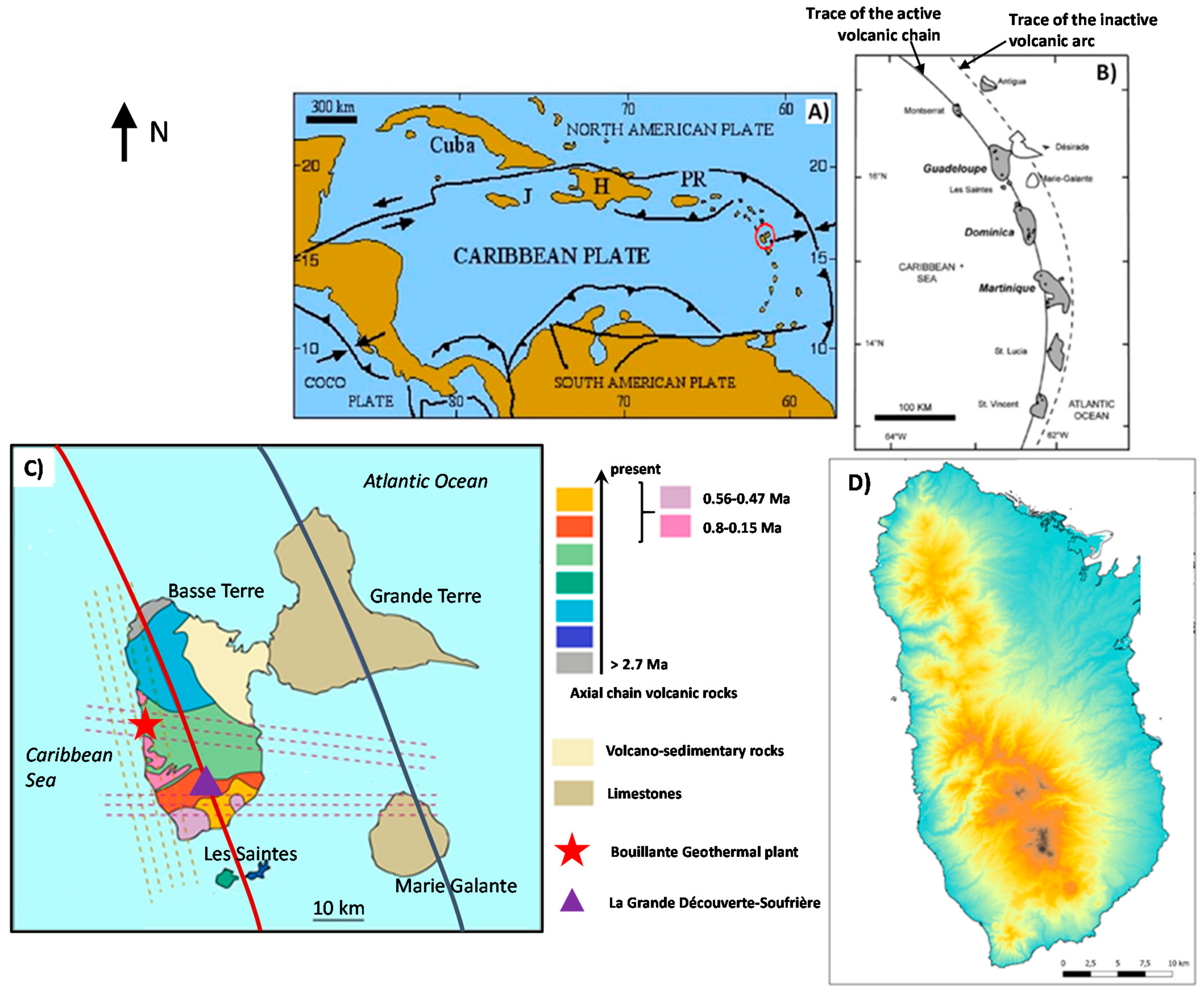
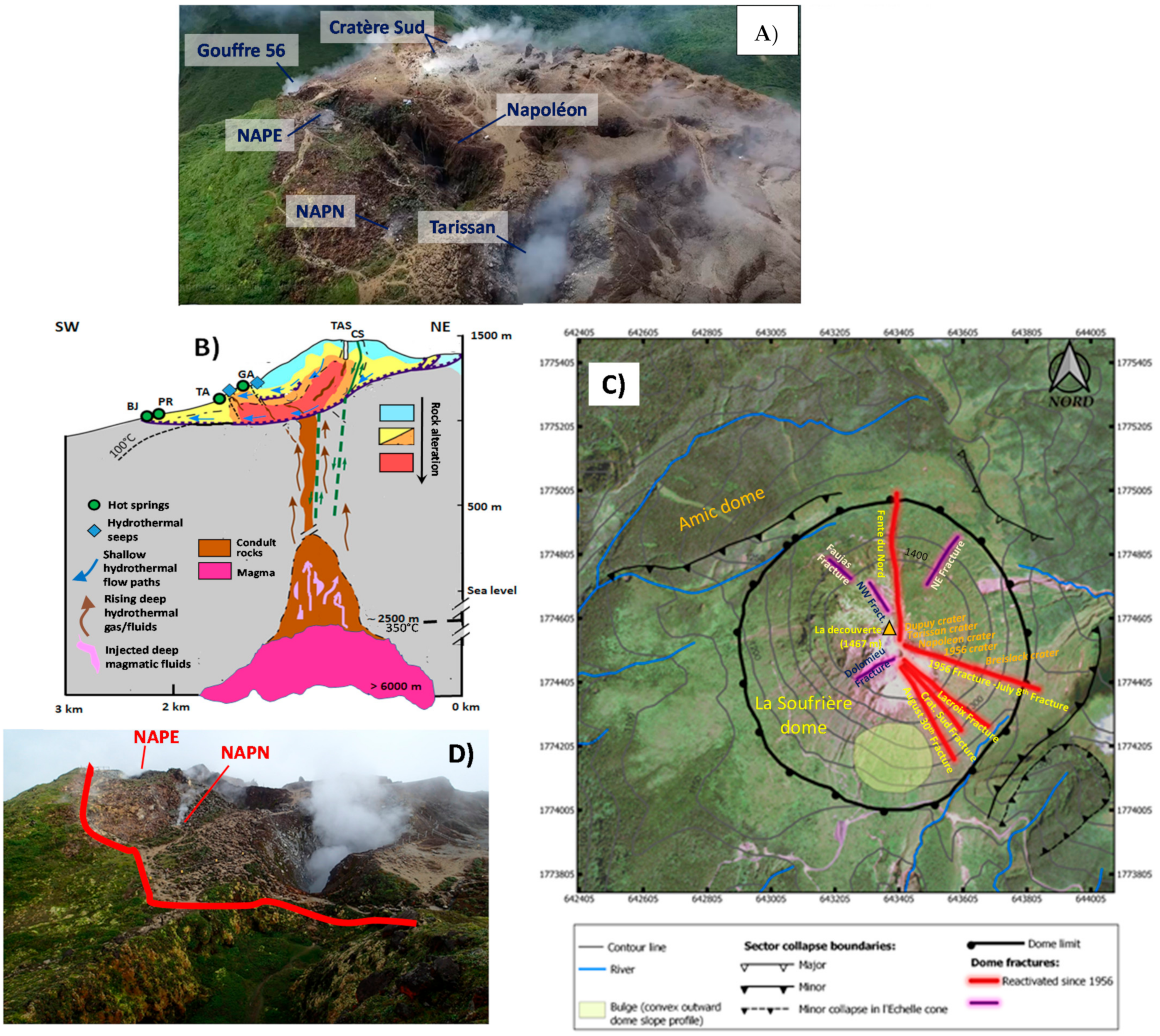

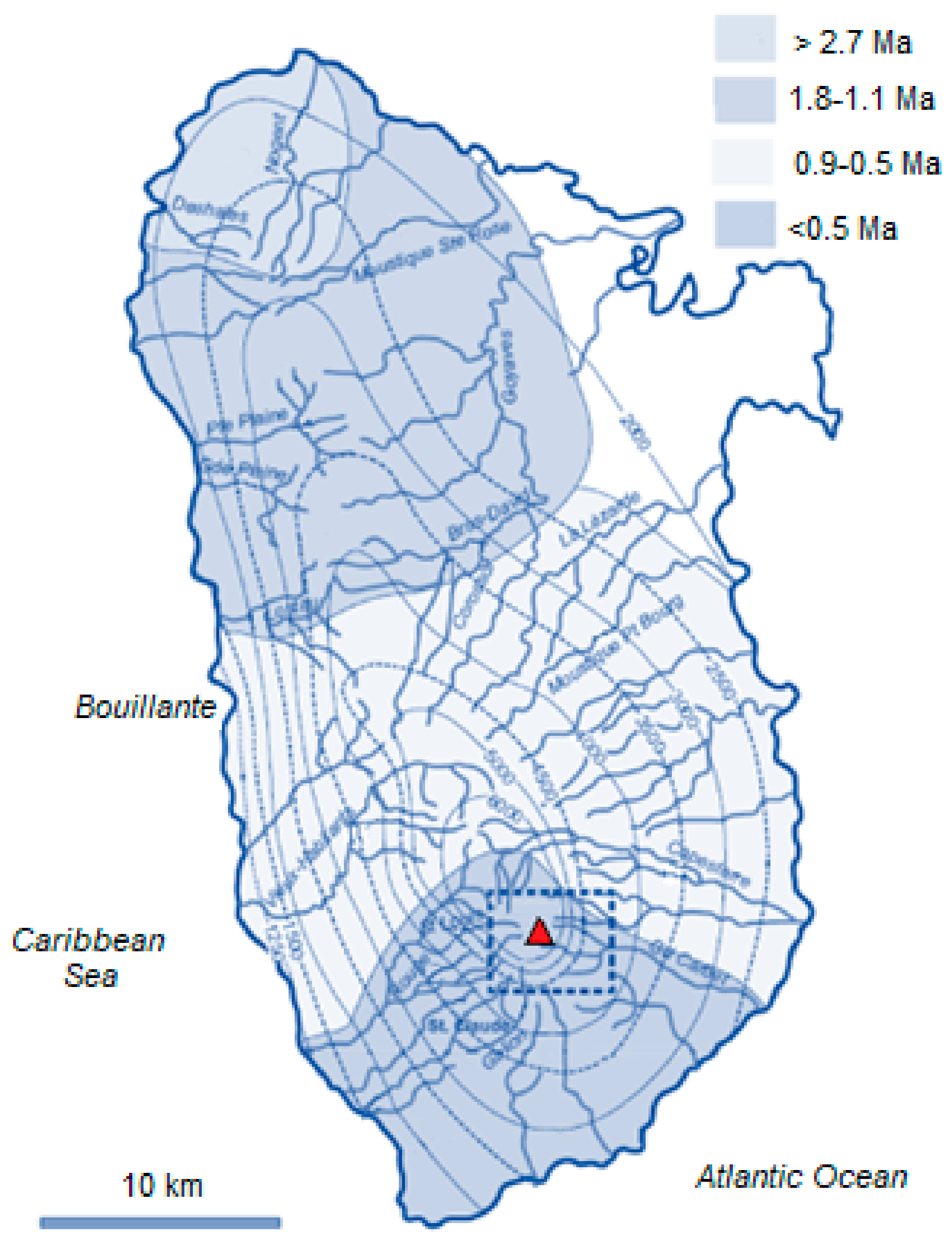

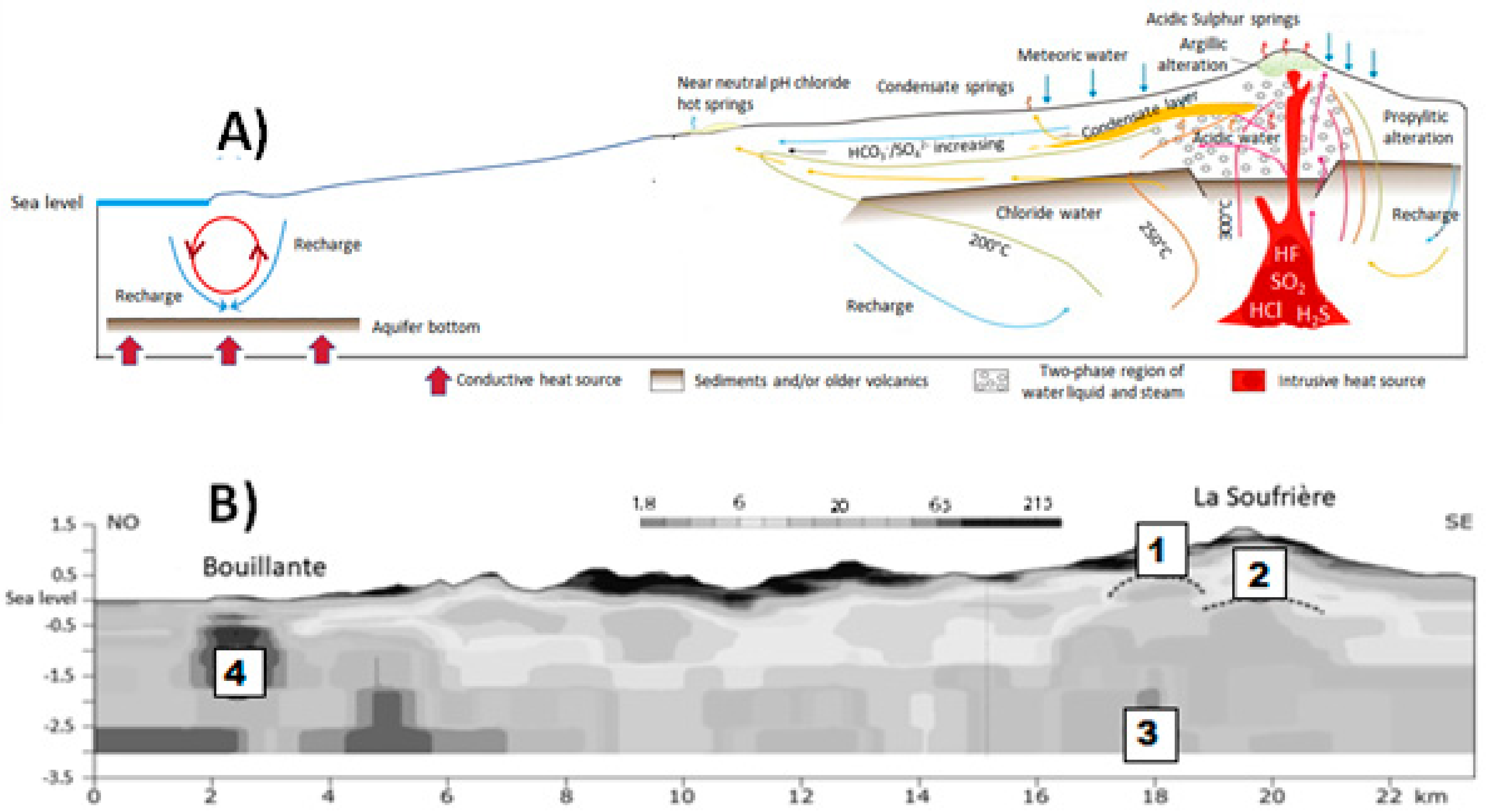




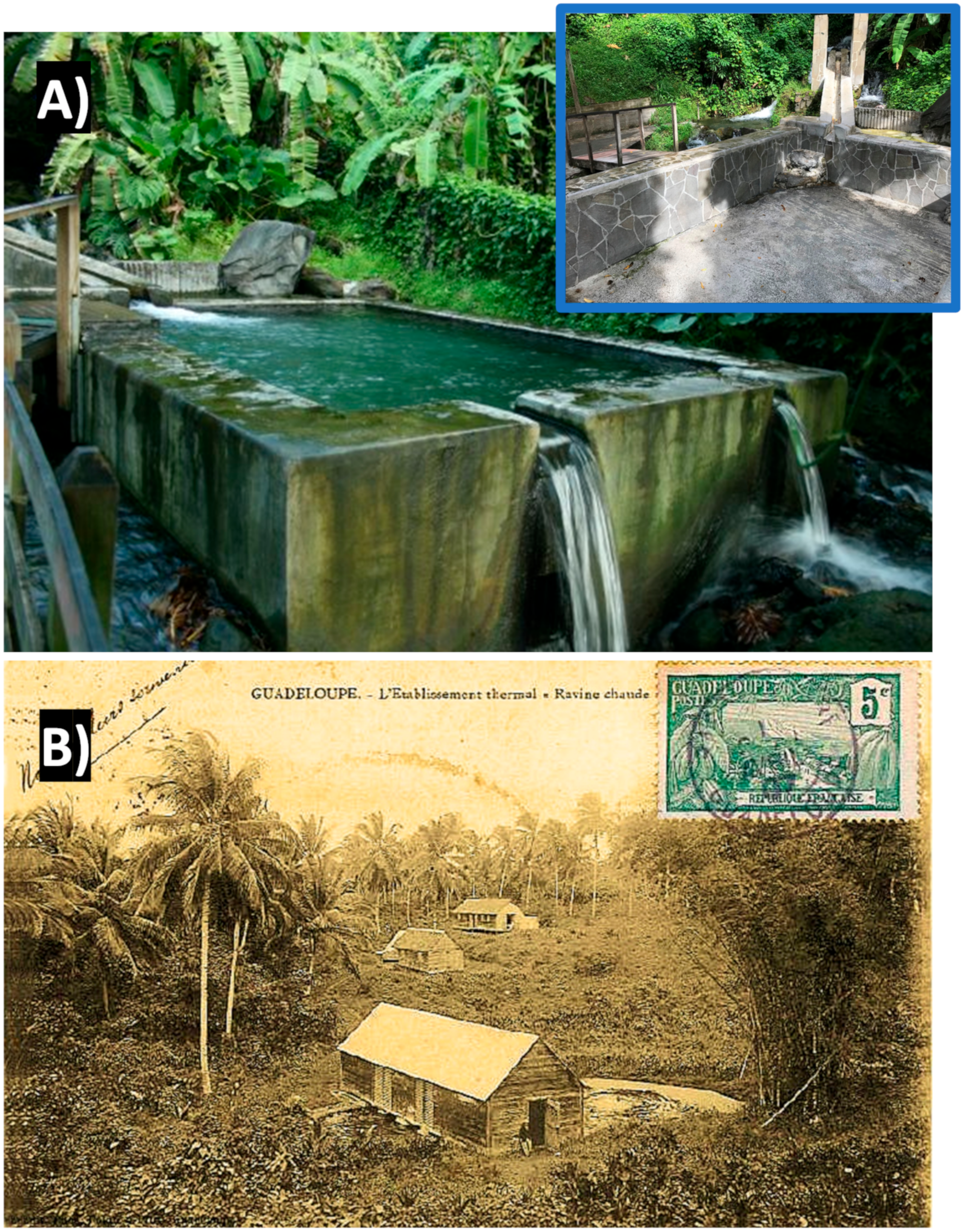
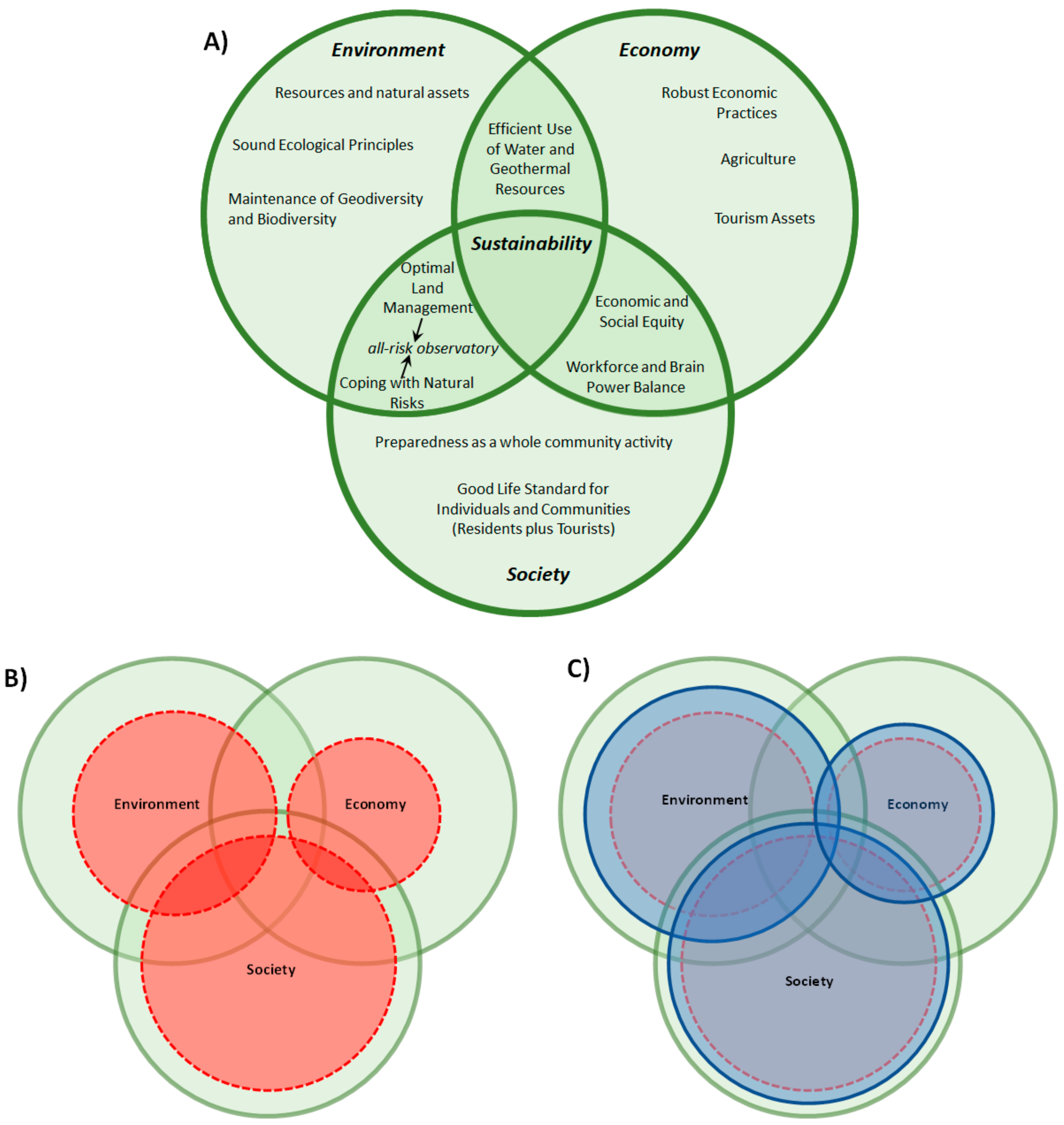
Publisher’s Note: MDPI stays neutral with regard to jurisdictional claims in published maps and institutional affiliations. |
© 2021 by the authors. Licensee MDPI, Basel, Switzerland. This article is an open access article distributed under the terms and conditions of the Creative Commons Attribution (CC BY) license (https://creativecommons.org/licenses/by/4.0/).
Share and Cite
Moretti, R.; Moune, S.; Jessop, D.; Glynn, C.; Robert, V.; Deroussi, S. The Basse-Terre Island of Guadeloupe (Eastern Caribbean, France) and Its Volcanic-Hydrothermal Geodiversity: A Case Study of Challenges, Perspectives, and New Paradigms for Resilience and Sustainability on Volcanic Islands. Geosciences 2021, 11, 454. https://doi.org/10.3390/geosciences11110454
Moretti R, Moune S, Jessop D, Glynn C, Robert V, Deroussi S. The Basse-Terre Island of Guadeloupe (Eastern Caribbean, France) and Its Volcanic-Hydrothermal Geodiversity: A Case Study of Challenges, Perspectives, and New Paradigms for Resilience and Sustainability on Volcanic Islands. Geosciences. 2021; 11(11):454. https://doi.org/10.3390/geosciences11110454
Chicago/Turabian StyleMoretti, Roberto, Séverine Moune, David Jessop, Chagnon Glynn, Vincent Robert, and Sébastien Deroussi. 2021. "The Basse-Terre Island of Guadeloupe (Eastern Caribbean, France) and Its Volcanic-Hydrothermal Geodiversity: A Case Study of Challenges, Perspectives, and New Paradigms for Resilience and Sustainability on Volcanic Islands" Geosciences 11, no. 11: 454. https://doi.org/10.3390/geosciences11110454
APA StyleMoretti, R., Moune, S., Jessop, D., Glynn, C., Robert, V., & Deroussi, S. (2021). The Basse-Terre Island of Guadeloupe (Eastern Caribbean, France) and Its Volcanic-Hydrothermal Geodiversity: A Case Study of Challenges, Perspectives, and New Paradigms for Resilience and Sustainability on Volcanic Islands. Geosciences, 11(11), 454. https://doi.org/10.3390/geosciences11110454







